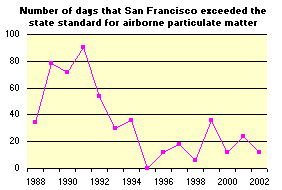PHYSICAL ENVIRONMENT
| ==> | Number of days SF exceeds the state standard for particulate matter |
| Percentage of solid waste diverted from landfill | |
| Percentage of San Franciscans surveyed who rate the cleanliness of the streets in their neighborhood as good or very good |
THE CITY'S AIR PARTICULATE LEVELS EXCEEDED STATE STANDARDS 12 TIMES IN 2002
|
Sources:
Bay Area Air Quality Management
District, Bay Area Pollution Summary (annual summaries, 1993-2001)
|
Particulate matter air pollution consists of very small floating particles that can be inhaled into the deepest parts of the lung. Particulate matter can aggravate respiratory problems such as asthma and bronchitis. Sources of particulate matter include industrial emissions, motor vehicles, road dust, construction, demolition and residential wood smoke. The state standard for the maximum amount of particulate matter in the air in a 24-hour period is 50 micrograms per cubic meter (mcm). San Francisco has exceeded the state standard (which is stricter than the federal) for particulate matter on some days in the past few years, including 12 days in 2002. However, the City has had far fewer days in which it exceeded state standards than in years 1989 -1992. The City has not recently exceeded state or federal standards for ozone or nitrogen oxide. |
For more information:
- Data (Excel)
- San Francisco Department
of the Environment Web site (http://sfgov.org/sfenvironment/index.htm)
last updated 5/24/04
